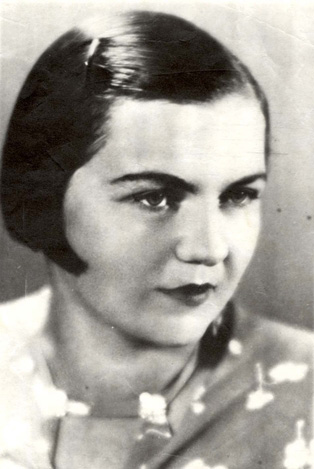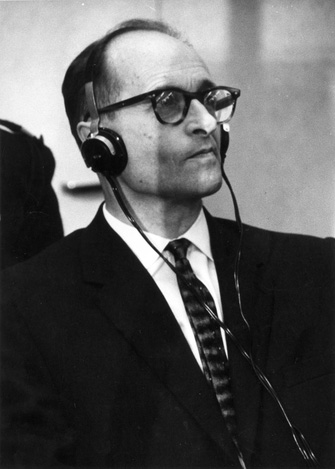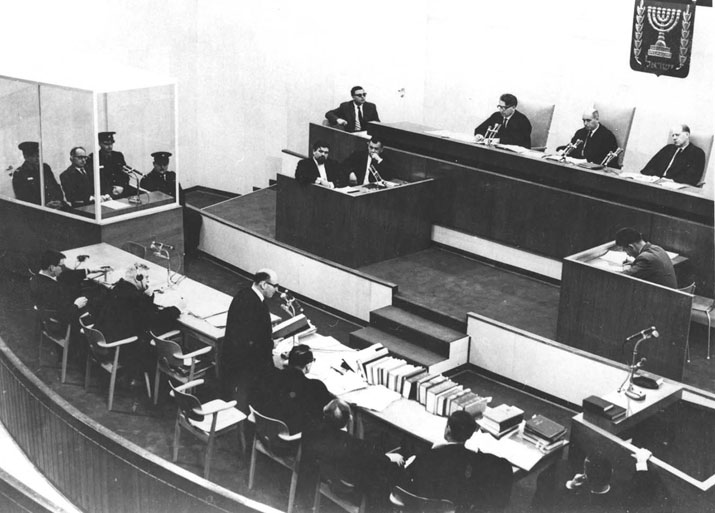Adolf Eichmann’s role in the “Final Solution” is one that has been described in different terms since the end of World War II, especially as Nazi hunting and war crimes trials were beginning. Eichmann served in the Gestapo and the SS as chief of RSHA (Department of Security), and was ultimately responsible for the deportation of over 1.5 million Jews from all over Europe to killing centers and sites in Poland and the Soviet Union. Touting himself and sometimes recognized by others as a mere bureaucrat who sat behind an office desk, it was the specifics of his job, which made him a notorious criminal. After World War II, he successfully fled to Argentina under the name Ricardo Klement, where he lived safely with his family for fifteen years. In 1960, Israeli members of the Mossad found Eichmann, abducted him, and brought him to Israel to stand trial.
Since the 1960s, Adolf Eichmann’s role in the “Final Solution” has been debated, as to whether or not his job was merely as a bureaucrat following orders or if he was a demonic figure, responsible for the work he did transporting Jews like cattle to their deaths. At the Wannsee Conference in January 1942, the genocide of European Jewry was coordinated. Beginning then and continuing through 1944, Eichmann was responsible for the machinery of deportation. He worked meticulously and thoroughly, firmly believing in what he was doing. The journalist Hannah Arendt, who attended the trial, claimed that Eichmann was a bureaucrat, like the CEO of a major corporation, whose work was genocide. However, for those who seek evidence of Eichmann as a demonic figure, the events of Hungary in 1944 offer plenty. When Germany occupied Hungary in March 1944, there were 750,000 Jews there. Within the next several months, 437,000 of them were ghettoized and deported to Auschwitz-Birkenau. Eichmann did not organize these deportations from his desk in Berlin, but traveled to Hungary to personally conduct this operation. He was so passionate about the deportations and murder of these Jews that he even argued with Himmler who was having second thoughts. At the trial, the destruction of Hungarian Jewry was deemed to merit a separate chapter of the indictment, and most accounts of Eichmann’s life treat the Hungarian episode as the pinnacle of his horrible accomplishments.1
Eichmann’s role in the “Final Solution” and the facts behind this heinous plan to entirely wipe out European Jewry, had not been known until the trial, fifteen years after the events had ended. Though Eichmann claimed to have no blood on his hands, it became clear during his interrogation, that documents dealing in the business of human cargo had Eichmann’s name on them.
The Trial
Adolf Eichmann was charged with fifteen counts of indictment. The first four counts included crimes against the Jewish people. The first count was for causing the deaths of millions of Jews, issuing instructions for the extermination of Jews in Germany, Axis and occupied countries, and ensuring that Auschwitz was supplied with Zyklon B gas. The second count accused Eichmann of subjecting millions of Jews to living conditions likely to bring about their physical destruction, enslaving them, ghettoizing them, and deporting them under inhumane conditions. The third charge covered ‘grave harm’ caused to millions of Jews through enslavement, starvation, mass arrest, beatings and economic boycott. The fourth count charged Eichmann with imposing sterilization and abortion on Jews in many places, including in Theresienstadt in 1942.
The next set of charges was in the category of crimes against humanity and war crimes. Under these headings, Eichmann was charged with murder, extermination, enslavement, starvation, and expulsion of the Jewish civilian population; persecution of the Jews on national, racial, and religious grounds; and specific acts of despoliation, expropriation, and plunder of Jews.
Eichmann’s offenses against non-Jews were the center of counts 9-12 of the indictment. These included deportation under inhuman conditions of 500,000 Polish civilians, 14,000 Slovenes, the deportation and concentration of tens of thousands of Gypsies, and the deportation of 100 children from Lidice to Poland, where they were allegedly murdered. The final three counts covered Eichmann’s membership in the hostile organizations of SS, SD, and the Gestapo.2
Though there was some international controversy surrounding Eichmann’s abduction from Argentina, Israel’s prime minister David Ben Gurion, strongly felt that he needed to be tried in Israel, “so the younger generation growing up and being educated in Israel, which has only a pale idea of the unthinkable cruelties committed, can learn what really happened.”3 While there had already been war crimes trials, such as the famous trials held in Nuremberg, Germany, the Eichmann trial aroused particular international interest and brought Nazi atrocities to the forefront of world news.
It was decided that the trial would be televised so that the world could watch and listen. Ironically, few Israelis watched the trial because Israel had no television service at the time. It was Americans who watched daily, privileged to have nearly live coverage as well as an hour-long summary at the conclusion of each day. A group of around 545 journalists, diplomats, and international VIPs had seats in the courtroom. Eichmann sat behind bullet-proof glass wearing a suit and displayed virtually no emotion throughout the trial. It is thought that this demeanor was part of the defense’s strategy to rebuke any argument that he was passionate about his work.
The trial was the first time where survivor testimony was heard publicly in Israel, and this played an important role in publicizing the atrocities that Eichmann committed. Ultimately, after much debate and refashioning the case against Eichmann, 110 Holocaust survivors were asked to testify to the impact of Nazi measures in western Europe and the anti-Jewish measures they had experienced from the 1930s until the end of the war. This type of testimony did not only focus on events in which Eichmann took part, because the prosecution searched for testimony and documents on every aspect of the Nazi campaign against Jews.4 In addition, other survivors came forward, claiming to have seen Eichmann in a particular ghetto or camp. While these testimonies could not always be trusted, it was important for the prosecution to hear from Avraham Gordon, who was the only survivor to testify that Eichmann had murdered someone with his own hands.
Eichmann was called on to testify about different pieces of documentation and evidence. He generally claimed that he was following orders, doing his job well, and would have wanted to continue doing this work just as efficiently as he had done it throughout the war.
On December 15, 1961, Eichmann’s judgment was given. On counts one, two, and three, crimes against the Jewish people, the judges found that between 1941 and 1945, there was not one place where the accused did not act in one way or another with a varying degree of intensiveness. However, they found no evidence of intent to destroy the Jews or cause conditions likely to their destruction in 1938-1941 and acquitted him on that charge. Except in the case of Theresienstadt, there was no evidence that Eichmann forced sterilization, so he was also acquitted on count 4. Eichmann was found guilty of crimes against humanity, counts five to seven. He was convicted of war crimes and crimes against non-Jewish victims, counts eight through eleven. While the bench did not find sufficient evidence to convict Eichmann of the alleged murder of children from Lidice, it did find him guilty of membership in the hostile organizations of the SS, SD, and the Gestapo. For these convictions, Eichmann was sentenced to death.
Eichmann was hanged at midnight on June 1, 1962 and his body was cremated. His final words were “Long live Germany, long live Argentina, long live Austria. These are the three countries with which I have been most connected and which I will not forget. I greet my wife, my family and my friends. I am ready. We’ll meet again soon, so is the fate of all men. I die believing in God.”
Eichmann’s trial was the first time that the Holocaust of European Jewry was the center of the war narrative. It stimulated the publication of biographies, document collections, and historical studies. The sight of survivors giving testimony and the sympathetic reception of their stories emboldened Jews within and outside of Israel to recall their experiences of persecution and endurance. This pivotal trial shaped not only the memory of this heinous criminal, but also the way in which the Holocaust is discussed and commemorated in society today.
Ways to Discuss the Eichmann Trial with Students
High school students are often interested in courtroom trials and learn about it through social studies courses. For that reason, discussing the Eichmann trial in the classroom can generate attentiveness and introduce another element of Holocaust history.
Below are a couple of suggestions for ways to approach this topic in the classroom:
- Hannah Arendt, a German-Jewish journalist who covered the Eichmann trial, published her columns in a book called Eichmann in Jerusalem, which was published in 1963. Her commentary and depiction of Eichmann shaped the icon that he became, and triggered massive controversy. Her book and the surrounding criticism might be a good place to start with students. It will raise questions about evil and the perpetrators of the Holocaust.
- Discussing Nazi hunting might also be a segue into the discussion of Eichmann’s capture and trial. After teaching students about the Holocaust, it is natural for them to ask about what happened to the criminals who committed these horrific acts. By discussing those who were located and how people are still trying to find and bring Nazis to justice, you will be able to discuss the Eichmann trial in a larger context.

.jpg)

.jpg)
.jpg)

